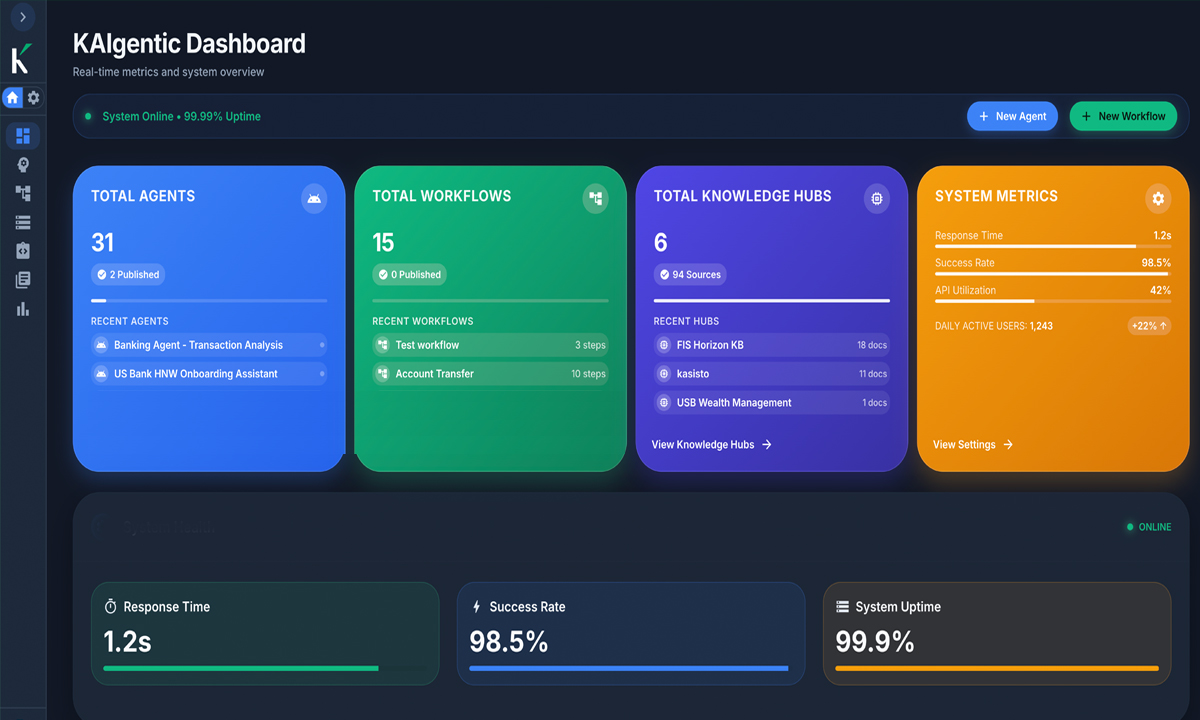Conversational artificial intelligence (AI) is a technology that enables computers to understand and respond to human language in a natural and human-like way. Through the creation of applications and services that communicate with people via text or speech, such as chatbots or virtual assistants, conversational AI works “hand-in-hand” with human employees.
According to the 2022 IBM Global AI Adoption Index, AI-driven tools are utilized at a rate of 35% across various industries, including healthcare, retail, and manufacturing. The financial services sector has experienced a rapid rise in AI adoption for fraud detection, risk management, investment management, and customer service.
While the financial sector has largely adopted artificial intelligence, we know that AI is still uncharted territory for many community banks and credit unions. One of the simplest ways to embrace conversational AI is through an intelligent digital assistant. This type of AI directly benefits your financial institution by augmenting and complementing your existing workforce.
An intelligent digital assistant, or IDA, is a forward-facing, “bank-smart” digital solution that addresses customer queries, provides detailed financial information, and acts as the first customer touchpoint for your brand. Intelligent digital assistants take the concept of a chatbot to the next level by adding personalized, growth-oriented, and relationship-focused conversations to the tried and true formula of digital customer support.
With these conversational AI platforms, your financial institution gains a source of complementary customer engagement that prepares you for the future of digital banking.
Conversational AI = The Ideal Complement
Per a November 2021 Forrester survey conducted on behalf of Blend, more than 40% of financial services executives in North America identified greater customer lifetime value as one of the top benefits of delivering highly effective personalized customer experiences.
To facilitate this kind of long-lasting value, it’s necessary to build a robust digital customer experience. IDAs provide this value by efficiently answering customer queries, delivering financial guidance, and more.
One of the most significant advantages of an IDA is its unique ability to complement and augment your existing workforce. It’s an addition to your existing team – by automating customer support, you give time back to your employees to focus on essential, growth-focused activities, like reaching new customers and marketing your services. And it works 24/7, so you have support after hours and on the weekends.
This success is all possible because of conversational AI. Before you build your personalized digital assistant, it’s important to understand how conversational AI works and its value to your IDA.
Conversational AI 101
Conversational artificial intelligence can be a complex subject. We’ve created a handy reference guide to make understanding the key components of an IDA powered by conversational AI easier.
A – AI-Assisted Channel. When your team implements an intelligent digital assistant, it adds a layer of advanced artificial intelligence to your existing channels.
B – Branded Solution. Your IDA is uniquely branded to your financial institution. It can have a distinct personality (like our friends over at BankSouth) and act as a digital and physical personification of your brand guide.
C – Continuous Learning. AI doesn’t exist in a vacuum – like a human employee, it learns and adjusts over time, getting more accurate and insightful every day.
D – Digital Experience. An IDA is a critical part of your overall digital experience – it can live on your website and/or mobile banking platform, serve as the mouthpiece for all digital communications (email, text message, etc.), and provide customers with personalized content and more.
E – Engagement. IDAs digitally engage customers, guiding them through their journey until they reach their destination. Over time, they learn your customers’ preferences and behaviors and provide personal, intuitive, human-like service whenever needed.
F – Financial Literacy. Pre-loaded with millions of responses aggregated from the world’s largest financial institutions, IDAs are powered by conversational AI to respond to customers’ financial questions with bespoke and accurate answers.
G – Growth-Oriented Tool. IDAs directly support your financial institution’s business growth by driving new customers to your products and services and retaining existing ones via personalized digital experiences.
H – Human Support. IDAs augment contact center team functions by removing monotonous daily tasks, like answering simple customer queries. This partnership of AI and humans works in tandem to increase your containment rate – your IDA handles the majority of customer questions so your human team can focus on strategic initiatives. They then provide valuable data to your customer support team, who uses it to enhance operations.
I – Integration. A conversational AI platform easily integrates into your existing Web properties – whether browser- or mobile-based, an IDA plugs into any digital front end. Kasisto IDAs also come pre-integrated with key components of your digital ecosystem, like digital banking and live chat systems, enabling users to enjoy hyper-personalized, data-rich experiences.
J – Job Optimization. Conversational AI is an added technology that powers the tools your team builds into their daily processes. By answering frequently asked questions, resolving account issues, and handling inquiries on topics ranging from credit cards to cryptocurrency, an IDA gives customers, members, and employees time back in their days.
K – Knowledge Base. Conversational AI operates off of a massive knowledge base that has been built over time. And it continues adding to that base as it interacts with more and more people.
L – Logical Conversation Patterns. Conversational AI is built with rules, patterns, or models that enable an IDA to understand and respond to user inputs logically and coherently.
M – Machine Learning. The ability of artificial intelligence to learn and “wrap in” new information, insights, and patterns from previous interactions with humans. Conversational AI leverages machine learning to continue conversations with customers and move them to the appropriate next steps on their digital journey with your financial institution.
N – Natural Language Processing. NLP uses unstructured data to help AI understand how humans speak and write. It’s essentially the backend programming that makes chatbots or IDAs sound human-like.
O – Omnichannel Service. IDAs deliver their service over a variety of platforms and channels. Websites, mobile apps, or even physical personifications serve as conduits for introducing your IDA to customers and members.
P – Personalized Interactions. Digital assistants use real-time, personalized financial data. And depending on how you build your IDA’s tone and voice, your customers can experience one-on-one personal attention. An IDA gives customers automated yet personalized recommendations that support their individual needs.
Q – Qualitative and Quantitative Data. Interactions with conversational AI give your teams valuable insights and analytics into what your customers are interested in, what they need help with, and what decisions they might make in the near future.
R – Robust Capabilities. Conversational AI has been around for a long time, even since the 1960s! Developed over several decades, this technology has the history and research behind it to be useful in new sectors, like financial services.
S – Self-Service. Once implemented, IDAs run independently, giving customers an efficient, 24/7/365 self-service option for their financial needs.
T – Total Automation. An IDA completely automates what were once time-consuming manual processes, like providing FAQs and account answers to customers or collecting customer data. This directly saves your financial institution time and money.
U – Ultra-Fast Implementation. IDAs have a rapid ramp-up time and can even go live in 30 days or less. This incredibly quick implementation process prepares you to serve customers with a fully customizable intelligent digital assistant.
V – Virtual Best Banker. As the newest member of your team, an IDA takes the best parts of a human employee to become your “virtual best banker.” Not only does it act as a customer’s first touchpoint in your digital experience, but it also functions as a brand ambassador for your financial institution, one that embodies your core values and messaging.
W – Win-Win Strategy. By implementing conversational AI in your financial institution, you provide dual success for your customers and employees. An IDA offers a convenient, approachable solution for your customers and a versatile, customizable tool for your team.
X – Expertise That Scales. IDAs come preloaded with relevant and up-to-date financial information specific to your consumers. Whether you’re a small FI, mid-tier bank, or large institution, an IDA has the right knowledge for you. This financial expertise derives from experiences with big banks that can translate to smaller ones.
Y – Your New Teammate. Your IDA is a new team member, and they should onboard as such. Make sure to introduce your IDA to your internal teams through a hands-on demonstration and announce the new teammate to external customers.
Z – Zero Days Off. AI doesn’t take any days off. Unlike your employees, your IDA works overtime, replying to customers’ financial needs at any time of the day or night, any day of the week.
Ready for Conversational AI in Your Financial Institution?
Now that you’re up to speed on some of the basics of conversational AI in finance, you might be interested in learning what an IDA could look like for your financial institution.
Plus, check out our Cornerstone Report, where we partnered with Cornerstone Advisors to examine how to make IDAs an integral part of your financial team.

